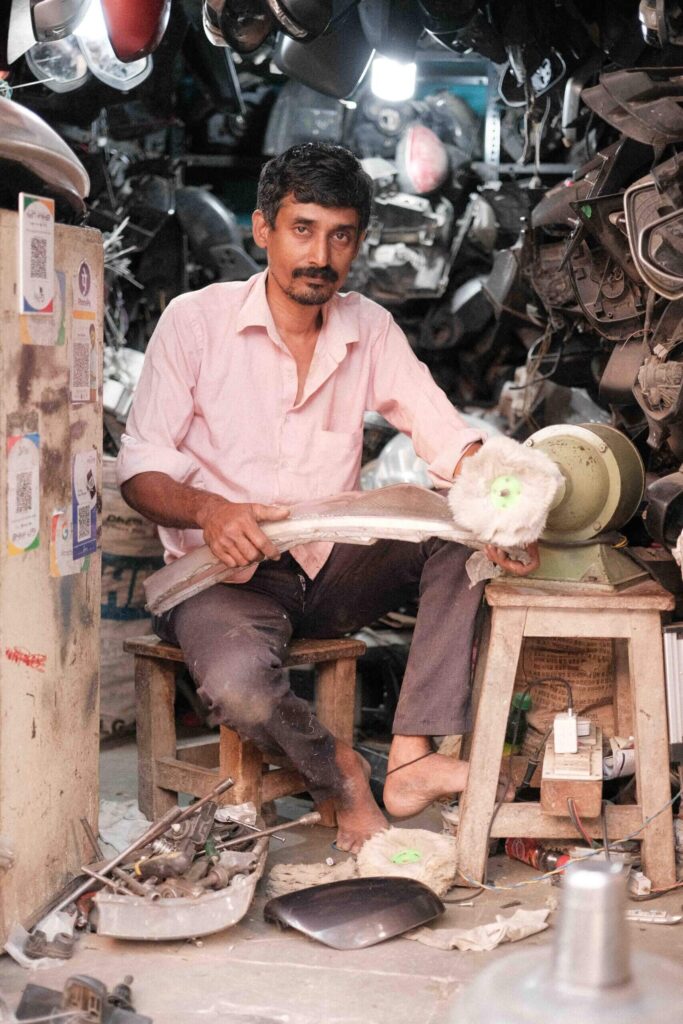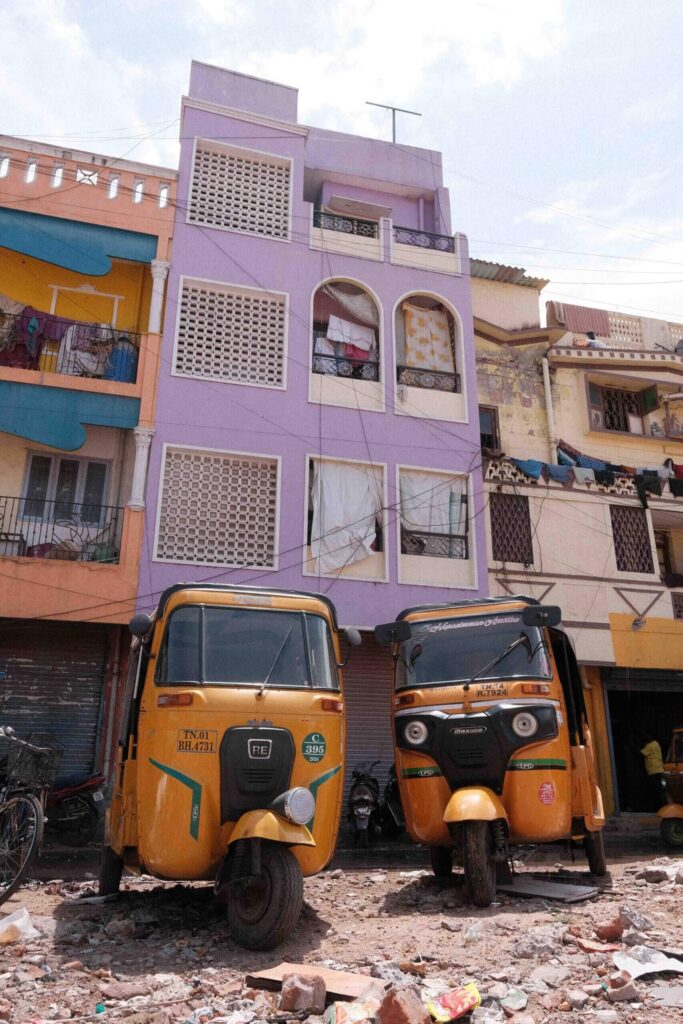For Fujifilm photographers who yearn for the nostalgic beauty of classic film, you’re in the right place. In this article, I deliver the Fujifilm Recipe: Kodak Gold. A timeless classic among the film stocks of yesteryear, Kodak Gold is known for its warm tones, vibrant colours, and aesthetic romanticism.
Location
To experiment with this film simulation, I visited a location in Chennai, India, known as Pudapet Bike Bazaar. A classically Indian suburb positioned just a few kilometres from the east coast beach. The area sparked my interest some days prior as I passed through on a rickshaw. From what I could see by hunching over my 6ft 3 frame to peer from under the weathered leather roof, the place appeared to be a lively street full of oil-stained mechanical commerce. And a perfect location to experience some raw Indian culture.
Moreover, the details about this place given by Magesh, my hotel manager, who was riding with me at the time, made me all the more curious to visit. “This is the place where all the stolen bikes in Chennai come.” “If you lose your bike in this city, it will undoubtedly end up here”, he noted with a scoff and light grin.
Unfortunately, After a short walk around the location, I realised it was far smaller than I had assumed. Instead of a busy network of backstreet chop shops I had expected to find off the main road, they were situated nearly entirely on it. On the one hand, I’m happy that the illegal bike trade in the city isn’t large enough to support a sizable black market. But on the other, it failed to give me the content I was searching for.
Originally I intended to produce a short feature article on the place and an accompanying YouTube video. However, after this discovery and a drop in value, it is relegated to a Fujifilm Recipe Simulation article. Moreover, perhaps due to the nature of the work, many were unaccommodating to my requests for photographs. Although, I did have a few lengthy and meaningful exchanges with the more agreeable characters there.
Positive Observations
Firstly, does the simulation generate images that look like film camera shots? Absolutely, yes. Secondly, do these images create an emulation that closely represents the aesthetic of the Kodak Gold film stock? Another categorical yes.
The Kodak Gold film stock is so distinguishable that I’m sure many film enthusiasts can think of it on que. It certainly could be chosen from an array of multiple choice photographs in a table. Its warmer tones, balanced contrast and colours create images with a nostalgic transcendency.
This Fujifilm Recipe does a perfect job capturing the original qualities of the Kodak Gold film stock. And if it is one appeals to you, I can thoroughly recommend it after my experience using it. It especially showed its strengths during the later hours of the afternoon as the sun was setting.
Although this time of day offers the best lighting for most photographic styles, the warmth and richness of this fujifilm simulation recipe combined with the glow of the declining sun offer images with a richness that made appealing the most mundane subjects.
Negative Observations
The characteristics that make this an exemplary Fujifilm Recipe: Kodak Gold are also the ones which limit its capacity. But this is a basic rule of colour theory. After all, you wouldn’t paint a room bright red when attempting to create feelings of calm and tranquillity. While this recipe is spot on at creating the thermal lavishness of Kodak gold, it certainly isn’t a multipurpose recipe.
For example, it was not suitable for capturing images of the mechanics and their workshops. Instead of warm tones and balanced contrast, these scenes and subjects required more contrast and clarity to bring forth the dirt and roughness of the environment.
Additionally, I observed that this Fujifilm Simulation Recipe did a disservice to the vibrancy of the colours of India. Which are present in their abundance everywhere you look. These images sacrifice this in pursuit of the warm nostalgic blanket they pull over the observer with tones of red that can push themselves too far.
Where And How To Use
If you are looking for a Fujifilm Recipe to generate images with warm tones, balanced colours and contrasts and nostalgic overtones, then this simulation is for you. It would specifically shine at family occasions or when photographing children and babies. Additionally, it is suitable if you are attempting to capture images with a more timeless quality.
It is not recommendable to utilise this Fujifilm Recipe in instances, like the mechanics workshops, where you want to create a sense of grit. Moreover, avoid this recipe in instances where depth is a crucial element in the images. The simulation renders very flat pictures and as such it should be used to deliver scenes which relate to the themes of light, nostalgic, warm, and vintage only.
The Recipe
- Film Simulation: Classic Chrome
- Grain Effect: Strong, Large
- Colour Chrome Effect: Weak
- Colour Chrome FX Blue: Off
- White Balance: K5800 – R2, B4
- Dynamic Range: 200
- Tone Curve: H0, S-1
- Colour: -1
- Sharpness: -1
- High ISO NR: -4
- Clarity: -2
View the entire collection of Fujifilm recipes by clicking here.
Another great source of Fujifilm recipes is Fuji x Weekly.
Conclusion
While it is not a versatile setting, overall, it is a decent simulation. That is if you are looking to generate images that conform to the style of the Kodak Gold film stock. It does an outstanding job of rendering images that match this timeless classic. Although, it does begin pushing the Reds to their limit in certain situations.
But like always, these images will render entirely different results from the ones you will achieve with your lenses, camera, and unique environment. I suggest dialling these in now and testing them yourself before you draw any conclusions.
Please, let me know your thoughts about this setting in the comments section below. Additionally, let me know about any future simulations you would like to see. Thanks for joining. See you next time.
































































